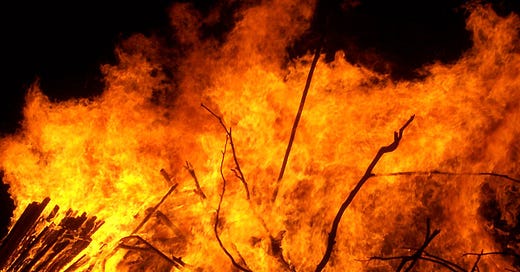Photo courtesy of Wikipedia
I concluded last week’s post with a quote from one of my favorite poems, “Little Gidding” by T.S. Eliot, in which the poet declares, “The only hope, or else despair / Lies in the choice of pyre or pyre— / To be redeemed from fire by fire.” He imagines our fate as having to choose between two different kinds of fire, likening mortality to the Shirt of Nessus: “The intolerable shirt of flame / Which human power cannot remove.” This shirt was stained with the blood of the centaur Nessus, whom Hercules had killed with an arrow poisoned with the venom of a Hydra. When Hercules puts the shirt on, the Hydra’s venom starts to cook him alive. In unendurable pain and unable to remove the garment, the hero builds a funeral pyre, and then throws himself upon it. The inevitability of suffering in life is the First Noble Truth of the Buddha. To be mortal means we are bound to suffer and die. And so, “We only live, only suspire / Consumed by either fire or fire.”
What the first kind of fire is should be fairly obvious. It is the fire that destroys, the fire that those on D-Day were under. But all of us have to face this fire in one form or another: war, natural disasters, hatred, disease, anger, aging, addiction, greed. It is the fire that ends in death; and it is consuming us all without exception. Like the knight in The Seventh Seal, each of us is playing a game of chess with death—a game which, no matter how well we play, we will ultimately lose. The fire is all around us. What then can we do? Should we eat, drink, and be merry, for tomorrow we die, fiddling while the world burns with us?
Our only hope, according to the poet, is another kind of fire. It is the fire of Pentecost, the fire that ignites. Fire takes life, but it can give life as well. I lived for a few years in the Flint Hills of Kansas. Every spring they would set fire to the prairies, burning the dead grass, leaving behind a charred moonscape. However, because their roots grew deep, the fire did not kill the plants, which were fertilized by the ash. Soon, new sprouts emerged and the hills were carpeted with emerald. Fire consumes, but it also gives light, warmth, and power. This is what the Holy Spirit does. The Spirit did not destroy Jesus’ disciples—it transformed them into apostles bringing the good news of God’s love into the world with power.
The fire of the Spirit leads us to life. In “September 1, 1939”, W.H. Auden declares, “We must love one another or die.” It is a beautiful hope, but that’s not how this life works. The second kind of fire does not free us from having to face the first. Auden himself realized this, amending the line to, “We must love one another and die.” Death takes life; and love is the way we choose to give our life. Eliot contends, “Love is the unfamiliar Name / Behind the hands that wove / The intolerable shirt of flame / Which human power cannot remove.” As we discussed two weeks ago, loving like Jesus did means laying your life down for others. This divine love of the Spirit sets us on fire to speak the truth and do what is right for one another regardless of the cost to ourselves.
The world is burning all around us. What can we do about it? Surely, I’m not the only one who is asking this question. As far as an answer, I agree with Eliot that we appear to have only two fundamental options. We could play with the first kind of fire, consorting with death, dealing it out to others in the hope that it will work to our advantage and delay the inevitable. In ways large and small, we see people doing this all the time, trying to profit from making the world worse. Or we can choose the other kind of fire, and let ourselves be consumed by the Spirit, making our lives a gift for the good of all. As much as we might wish for one, there is no safe option where we don’t get burned. For, as Jesus says, “whoever wants to save his life will lose it, but whoever loses his life for my sake and the sake of the good news will save it” (Mark 8:35).




